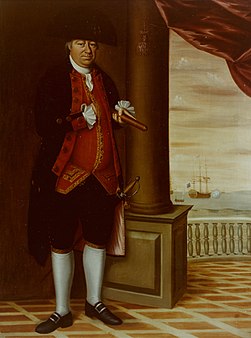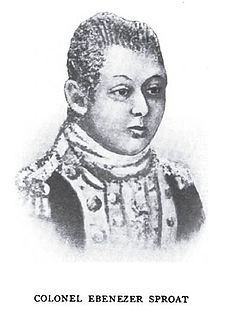Nathaniel Saltonstall | |
|---|---|
 Nathaniel Saltonstall marker in Marietta, Ohio | |
| Born | 1727 New London, Connecticut |
| Died | August 1807 (aged 79–80) Marietta, Ohio |
| Place of burial | |
| Allegiance | |
| Service/ | Connecticut militia, Connecticut naval privateer |
| Rank | Captain |
| Battles/wars | American Revolutionary War |
Nathaniel Saltonstall (1727–1807) was a Connecticut militiaman and a captain of Connecticut naval privateer ships during the American Revolutionary War [1] [2] [3] (not to be confused with another Connecticut naval officer with the same surname, Dudley Saltonstall).
In the United States uniformed services, captain is a commissioned-officer rank. In keeping with the traditions of the militaries of most nations, the rank varies between the services, being a senior rank in the naval services and a junior rank in the ground and air forces.

A privateer is a private person or ship that engages in maritime warfare under a commission of war. The commission, also known as a letter of marque, empowers the person to carry on all forms of hostility permissible at sea by the usages of war, including attacking foreign vessels during wartime and taking them as prizes. Historically, captured ships were subject to condemnation and sale under prize law, with the proceeds divided between the privateer sponsors, shipowners, captains and crew. A percentage share usually went to the issuer of the commission. Since robbery under arms was once common to seaborne trade, all merchant ships were already armed. During war, naval resources were auxiliary to operations on land so privateering was a way of subsidizing state power by mobilizing armed ships and sailors.

The American Revolutionary War (1775–1783), also known as the American War of Independence, was an 18th-century war between Great Britain and its Thirteen Colonies which declared independence as the United States of America.
Nathaniel Saltonstall was in command of the "old fort" at New London, Connecticut at the start of the war, [4] and subsequently served as a naval commander in service of Nathaniel Shaw of New London. [1] Saltonstall served as first lieutenant on the first voyage of the 24-gun ship General Putnam; he was commissioned as captain for the second voyage of the Putnam:

New London is a seaport city and a port of entry on the northeast coast of the United States, located at the mouth of the Thames River in New London County, Connecticut. It was one of the world's three busiest whaling ports for several decades beginning in the early 19th century, along with Nantucket and New Bedford, Massachusetts. The wealth that whaling brought into the city furnished the capital to fund much of the city's present architecture. The city subsequently became home to other shipping and manufacturing industries, but it has gradually lost most of its industrial heart.
Nathaniel Shaw Jr. (1703—1778) was a Connecticut Patriot, and an American Revolutionary War soldier.
First lieutenant is a commissioned officer military rank in many armed forces and, in some forces, an appointment.
You are to go on board our ship Putnam armed and fitted in a warlike manner for a cruise against the enemies of the Independent States of America as per your commission and instructions from the President of Congress and whose instructions you are to strictly obey. [5]
Saltonstall captured several prizes while captain of the Putnam. [1] He additionally served as captain of the ship Le Despencer. Later in the war, Captain Saltonstall led volunteer soldiers during the Battle of Groton Heights. [6] Later in life, Nathaniel Saltonstall moved to Marietta, Ohio, where he died on August 1, 1807. [6] He is buried at Mound Cemetery in Marietta, [7] along with Commodore Abraham Whipple of the Continental Navy and many other American Revolutionary War soldiers and pioneers.

The Battle of Groton Heights was a battle of the American Revolutionary War fought on September 6, 1781 between a small Connecticut militia force led by Lieutenant Colonel William Ledyard and the more numerous British forces led by Brigadier General Benedict Arnold and Lieutenant Colonel Edmund Eyre.

Marietta is a city in and the county seat of Washington County, Ohio, United States. During 1788, pioneers to the Ohio Country established Marietta as the first permanent settlement of the new United States in the Territory Northwest of the River Ohio. Marietta is located in southeastern Ohio at the mouth of the Muskingum River at its confluence with the Ohio River 11 miles northeast of Parkersburg, West Virginia. The population was 14,085 at the 2010 census.

Mound Cemetery in Marietta, Ohio is a historic cemetery developed around the base of a prehistoric Adena burial mound known as the Great Mound or Conus. The city founders preserved the Great Mound from destruction by establishing the city cemetery around it in 1801.
Lake Saltonstall and Saltonstall Mountain in Branford, Connecticut are named in his honor.

Lake Saltonstall is a long narrow lake located in south-central Connecticut. It covers an area of approximately 0.66 square miles (1.7 km2) and is nestled in the center of the trap rock Saltonstall Mountain. The lake is surrounded by forest and serves as part of the local water supply for surrounding towns.
Saltonstall Mountain, also known as Saltonstall Ridge, with a high point of (est.) 320 feet (98 m) above sea level, is a traprock mountain ridge located 3 miles (5 km) east of New Haven, Connecticut and 1.75 miles (2.8 km) north of Long Island Sound. It is part of the Metacomet Ridge that extends from Long Island Sound near New Haven, Connecticut, north through the Connecticut River Valley of Massachusetts to the Vermont border. Saltonstall Mountain is known for its 100 foot (30 m) scenic cliff faces and sharp ridgeline, unique microclimate ecosystems, rare plant communities, and for Lake Saltonstall, a 3 miles (5 km) long by 0.3 miles (400 m) wide municipal reservoir nearly enclosed by the mountain. Saltonstall Mountain is traversed by a number of hiking trails managed by the South Central Connecticut Regional Water Authority (SCCRWA) and Branford Land Trust.

Branford is a shoreline town located on Long Island Sound in New Haven County, Connecticut, 8 miles (13 km) east of New Haven. The population was 28,026 at the 2010 census.









